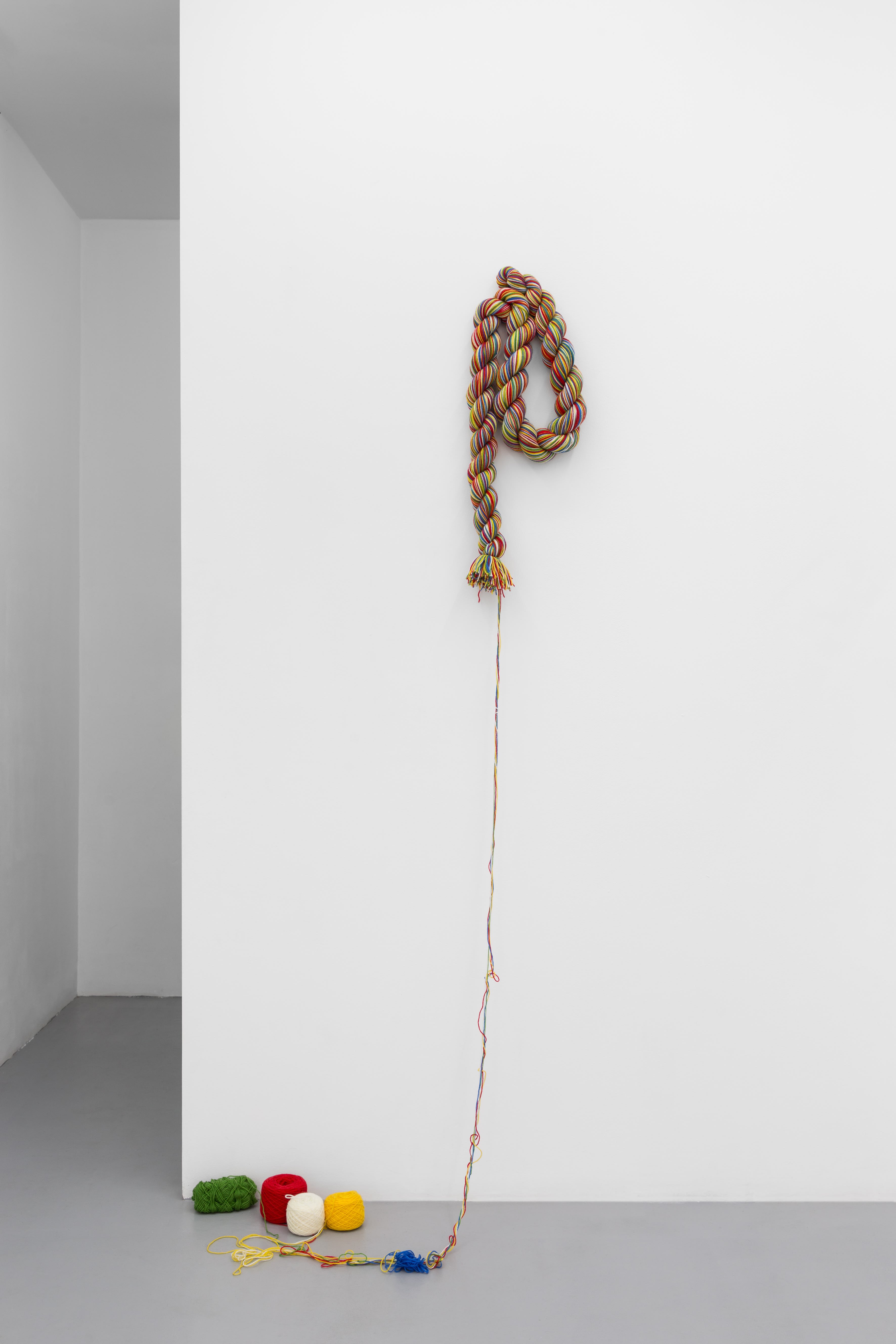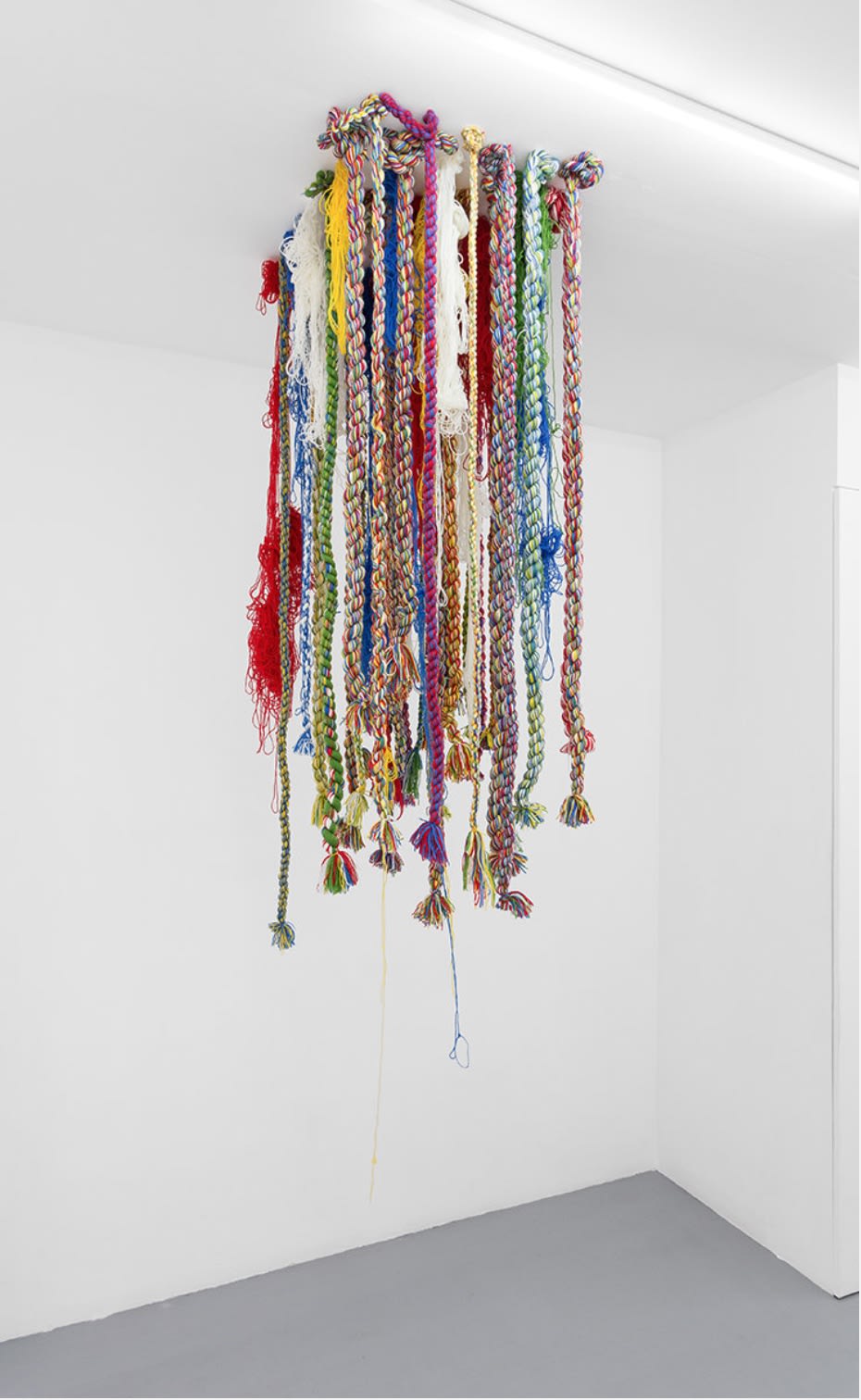
Let us start with a series of works: the drawings are made out of soap, ‘Preem’ to be precise. This is the name of a South African low-budget soap which has informed large parts of your work. While you started using the soap for performances and installations, you recently created a series of works on paper, OoNontombi, 2019. What is the motif and meaning behind these works?
I call them paper-paintings, they are experiments. I wanted to see how the material works under specific conditions. The works are about what it means for a girl and woman to be clean, purified. There is a relationship between the clean white paper and the body: once you touch it, you dirt it. This is the same sentiment the body carries, but not black female bodies.
You said that you remember the soap bar to be cut into pieces, each one of them for a particular purpose – laundry, dishes, body cleansing. Did you cut the soap you have used for the drawings in pieces; and was it a kind of ritual feel in making these?
There was no specific way [in which I prepared the soap] and it was not the same. I have to make sure the soap works differently in this process. Finding a way to make sure the soap works and changes form, is a ritual in itself.
The drawings are strongly associative. To me, many of them seem like mysterious water creatures, a combination of dragons, polliwogs and primeval time beings. On the other hand, they evoke traces, and with their form resembling such accidental marks; yet their lightness and delicacy making them impossible to be afraid of. What do you see in these drawings, do they have a particular form or meaning for you?
The message is what the drawings are about; I also like that people make their own assumptions. They are made on paper, and evoke the body which should be handled with care, with some form of fragility. In turn, the drawings represent the black female form and its fragility, which should be addressed with equal care and awareness.
You work in very different mediums, performance included. Paper represents the most traditional medium. What role does the medium 'work on paper' have in relation to your installation-, video and performance-work?
It is always about how the work speaks or what the work lends itself to. Generally, I don’t think in traditional media borders or any confined concepts within my work.
Lately, you have created installations with colorful cords hanging from the ceiling, Ibutho, 2019. These works form an entirely new approach. What initiated these works, what are the thoughts behind them?
All my work is experiment. I integrate new material, as well as taking former elements from something that has been in other works before. The cords, for example, appeared in AmaHubo (2018) and iGagazi (2015).
What about their colorfulness?
The colors in Ibutho are green, blue, red, yellow, white. These are the colors churches take to harness the spirits. Ibutho means 'war' or 'war regime'. The work is about women’s collectivity and the resilience of the black body.

Buhlebezwe Siwani, Installation view, Ibutho, 2019, Wool and rope, Image: Courtesy of the artist and Madragoa, Lisbon, Photo credit: Bruno Lopes
Does color play a specific role in your work? Are there any specific color connotations?
Color is specific, the meaning changes depending on where you are and who you are. I choose colors depending on the work; it is a layered process. For example, if I added Black to the colors in Ibutho, it would be the colors of the South African Flag which would add a completely other layer to the work.
A large part of your artistic practice consists in performances which you record in photographs or videoworks. In Eziko, 2018, one can see you with your head placed on a bowl. In the next frame, you are shown in a long white dress, sitting cross-legged in an open space, with a chicken placed in front of your dress. What was the performance about?
“Eziko” means “the kitchen outside”. The work refers to a series of videos I made on how labor changed South Africa, how Christianity coopted the land and people. What I am basically saying in this work is, we are being slaughtered. All things I am doing, are related to African belief systems, which in large parts are demonized or not practiced anymore today.
The early performance Mhlekazi, 2016, showed you bathing in a rural river, covered in white paint and wearing a white dress. The title translates 'Mister'. What did the mister do in the river?
Yes, it does mean mister. But “Mhlekazi” is also a term which is used for people with gifts, traditional healers. This piece is about the element of water and its place in the spiritual world. In fact, that we don’t know what is in 80% of water, only 20% is known to scientists. In the spiritual world one believes that people are in water, who have been called there by the spirits. The water is seen as an ancestral realm.
In Germany, we would have a debate now on why one word has a double meaning of ‘mister’ and meaning of ‘a gifted person’; about why has the gifted person to be male. Are you addressing these issues with the title?
No, not primarily. There are no gendered terms in Xhosa language at all. I did not think about this until I came to University. I started to critically engage with it and question meanings and form.
So, given that in Xhosa language there is no gender: would you say that this is but one aspect where the culture could function as a role model?
Oh no, Xhosa culture is still very patriarchal.
Your titles translate from Xhosa, a South African language and culture. What is the motivation behind it?
My work is about my culture, for my people, stemming from my real-life experience. The reason why I entitle my works in Xhosa is simply because I want to speak to my people in my language.
In earlier works, the relation between death and life, the living and the dead were of crucial importance. How far does it play a role in your current practice?
It still does inform my work, although rather indirectly. Every spirit lives in a liminal space, and I explore what it means to be a human being in-between worlds. This is similar to the relations of life and death.
You once said you used your own body for your performances because you know what it has been through, what you can load onto it and what is too much. Given this decision, what is your opinion about performances such as Tino Seghal’s?
I do like Tino Seghal’s work, but I am not a white man. We don’t share the same experiences; therefore, our subject matter is completely different.
Are their any specific female performance artists you do feel more connected to?
I like turning to performance artists such as Coco Fusco or Ana Mendieta which offer me a different window to the world.

Buhlebezwe Siwani, Installation view, Uhlanga, 2019, Wool, ropes, steel, Image: Courtesy the artist and Madragoa, Lisbon, Photo credit: Bruno Lopes
Your work has been exhibited internationally. Do you feel differences in the reception of your work in e.g. The Netherlands, Lithuania, Brazil or South Africa?
I never think about the specific space a work is created for. A work of art is always about integrity and an emotional connection. If a work has integrity, the reception is always similar. If a work doesn’t touch, it doesn’t matter. There are definitely differences in the places, people have their own way to navigate the world. People will write what they want to, I am not into these egocentric veins or opinions.
You once described your practice as “culturally political”. How does living and working in Amsterdam inform your politically artistic practice, given that many of your topics are closely bound to South African culture and the continent? Does the city offer an advantage for you?
I can work wherever. I’d like to be creating at home [in South Africa]. It’s easier to make work from where your subject is from. I uphold the premise of trying to make sure, that the work I am making, is speaking back to where I am. The Dutch – South African relations have a history, which makes it easy to be bound in Amsterdam. Apart from that, it is simply easier because my gallery is in Europe and I am showing in Europe most of the time. This way, I save 14 hours of flight each time.
You just completed a residency at the Cité International des Arts in Paris. Did living in Paris influence your work?
My experience of Paris was very good. This might also have been due to being confined. Two weeks after my arrival, the confinement started. I could hardly visit and places, so I worked in the studio at la Cité International des Arts most of the time. Imagine it like a boarding school full of artists.
Has the art residency fostered new ideas or approaches?
The work I am showing at the Musée d’Art Moderne right now was on commission. I began the research before coming in October and have continued during the residency. The idea, thus, existed before and developed during the stay. I am generally very experimental in my approach to media, so I was not particularly looking for new approaches in this regard.
The city of Paris is stony and often hostile in the first place. Did you feel ‘at home’ with your subjects and experiences?
Everywhere has spirits, and religion – it is very present in Paris – so Paris as a city is also spiritual. Every city close to water, has its spirits, and in Paris there are many dead bodies which also adds to this. There is a big African diaspora in districts like Chateau-Rouge, Barbès or Saint-Denis with their different and very own belief systems. So, yes, I did feel a relation between the city and my topics and ideas.
You are among the participating artists for the ‘African Space Art Project’. In short, this project will send an artwork by an African artist into space in 2021. How did you get to know about the project?
I was invited by the committee. However, we have not been given notice, or the green light to share any details yet.
In an earlier interview you spoke about the social responsibility of artists, and your personal claim to honesty/authenticity within your work. Seeing the difficulty for an authentic answer here, is it difficult to stay honest in the contemporary art business by times?
A work of art is about integrity and honesty to yourself. If the honesty is upheld, it feeds into your work. Sometimes it is not easy to navigate the art world, there are definitely superficial layers. There is also a wanting and a need to stay alive, using the tools you have learned. It can be difficult sometimes; it is a tough place to navigate.
Interview conducted by Christina-Marie Lümen